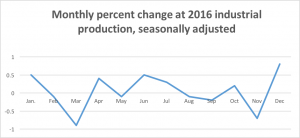By Mengjie(Jessie) Jiang
Industrial production in the United States swung to a better-than-expected increase in December, boosted by output at utilities and manufacturers, suggesting a positive advance look at economic growth.
Industrial production–a measure of output at factories, mines and utilities–rose a seasonally-adjusted 0.8 percent in December from a downward-revised 0.7 percent decline in November, the Federal Reserve reported Wednesday. That’s a rise than the 0.6 percent increase economists surveyed by Bloomberg had expected.

(Mengjie Jiang/MEDILL)
“The report suggests that the economy was growing modestly in December,” said Dale Rosenthal, assistant professor at the University of Illinois at Chicago. This was “probably due to the election uncertainty going away and firms resuming longer-term planning and projects.”
Manufacturing output moved up 0.2 percent as a spurt in metals and motor vehicles and parts was partially offset by declines in nondurable goods production, mostly at textile and product mills.
“Through the volatility, the trend in manufacturing is probably at least modestly positive and the oil-drilling-led plunge in mining seems to have ended,” said Jim O’Sullivan, economist at High Frequency Economics.
Manufacturing rose at a 0.7 annual rate in the fourth quarter but remained unchanged from its level in the same period a year earlier.
Utilities production jumped 6.6 percent after three months of decline, the strongest gain since December 1989. The move was boosted by a swing in the weather to slightly colder than normal from extremely mild in November.
Mining production was unchanged due largely to gains in crude oil extraction offset by declines in other mining categories.
Overall capacity utilization, a gauge of how much factory capacity is in use, ticked up 0.1 percentage point to 75.5 percent, slightly above the 75.4 percent consensus. Utilization in the manufacturing component, though up 0.1 percentage point to 74.8 percent, was 3.7 percentage points below the historical average of 80 percent.


